Linear Equations in Two Variables (Mathematics) Class 9 - NCERT Questions
The cost of a notebook is twice the cost of a pen. Write a linear equation in two variables to represent this statement. (Take the cost of a notebook to be ₹x and that of a pen to be₹ y).
SOLUTION:Let the cost of a note book =
₹x
and the cost of a pen = ₹ y
According to the condition, we have
[Cost of a notebook] = 2 x [Cost of a pen]
[Cost of a notebook] = 2 x [Cost of a pen]
i.e. (x) = 2 x (y) or, x = 2y
or, x - 2y = 0
Thus, the required linear equation is x - 2y = 0.
Express the following linear equations in the form ax + by + c = 0 and indicate the values of a, b and c in each case.


(iii) -2x + 3y = 6 (iv) x = 3y
(v) 2x = - 5y (vi) 3x + 2 = 0
(vii) y - 2 = 0 (viii) 5 = 2x
(i) We have 2x + 3y =

or (2)x + (3)y +  = 0
= 0
Comparing it with ax + by + c = 0, we get a = 2, b = 3 and
c = 
(ii) We have 

Comparing it with ax + by + c = 0, we get

(iii) We have -2x + 3y = 6
or (-2)x + (3)y + (-6) = 0
Comparing it with ax + by + c = 0, we get a = - 2, b = 3 and c = - 6.
(iv) We have x = 3y or (1)x + (-3)y + (0) = 0
Comparing it with ax + by + c = 0, we get a = 1, b = -3 and c = 0.
(v) We have 2x = -5y or (2)x + (5)y + (0) = 0
Comparing it with ax + by + c = 0, we get a = 2, b = 5 and c = 0.
(vi) We have 3x + 2 = 0
or (3)x + (0)y + (2) = 0
Comparing it with ax + by + c = 0, we get a = 3, b = 0 and c = 2.
(vii) We have y - 2 = 0
or (0)x + (1)y + (-2) = 0
Comparing it with ax + by + c = 0, we get a = 0, b = 1 and c = -2.
(viii) We have 5 = 2x
⇒ 5 - 2x = 0 ⇒ - 2x + 0y + 5 = 0
⇒ (-2)x + (0)y + (5) = 0
Comparing it with ax + by + c = 0, we get a = -2, b = 0 and c = 5.
Which one of the following options is true, and why?
y = 3x + 5 has
(i) a unique solution
(ii) only two solutions
(iii) infinitely many solutions
Option (iii) is true because a linear equation has an infinitely many solutions. Moreover when represented graphically a linear equation in two variables is a straight line which has infinite points and
hence, it has infinite solutions.
Write four solutions for each of the following equations:
(i) 2x + y = 7 (ii) px + y = 9 (iii) x = 4y
(i) 2x + y = 7
When x = 0, 2(0) + y = 7
⇒ 0 + y = 7 ⇒ y = 7
 Solution is (0, 7)
Solution is (0, 7)
When x = 1, 2(1) + y = 7
⇒ y = 7 - 2 ⇒ y = 5
 Solution is (1, 5)
Solution is (1, 5)
When x = 2, 2(2) + y = 7
⇒ y = 7 - 4 ⇒ y = 3
 Solution is (2, 3)
Solution is (2, 3)
When x = 3, 2(3) + y = 7
⇒ y = 7 - 6 ⇒ y = 1
 Solution is (3, 1).
Solution is (3, 1).
(ii) px + y = 9
When x = 0, p(0) + y = 9
⇒ y = 9 - 0 ⇒ y = 9
 Solution is (0, 9)
Solution is (0, 9)
When x = 1, p(1) + y = 9
⇒ y = 9 - p
 Solution is (1, (9 -p))
Solution is (1, (9 -p))
When x = 2, p(2) + y = 9 ⇒ y = 9 - 2p
 Solution is (2, (9 - 2p))
Solution is (2, (9 - 2p))
When x = -1, p(-1) + y = 9 ⇒ -p + y = 9
⇒ y = 9 + p
 Solution is (-1, (9 + p))
Solution is (-1, (9 + p))
(iii) x = 4y
When x = 0, 4y = 0 ⇒ y = 0
 Solution is (0, 0)
Solution is (0, 0)
When x = 1, 4y = 1
 Solution is
Solution is 
When x = 4, 4 = 4y

 Solution is (4, 1)
Solution is (4, 1)
When x = -4, 4y = -4

 Solution is (-4, -1).
Solution is (-4, -1).
Check which of the following are solutions of the equation x - 2y = 4 and which are not:
(i) (0, 2) (ii) (2, 0)
(iii) (4, 0) 
(v) (1, 1)
(i) (0, 2) means x = 0 and y = 2
Putting x = 0 and y = 2 in x - 2y = 4, we have
L.H.S. = 0 - 2(2) = - 4. But R.H.S. = 4
 L.H.S. ≠ R.H.S.
L.H.S. ≠ R.H.S.
 x = 0, y = 2 is not a solution.
x = 0, y = 2 is not a solution.
(ii) (2, 0) means x = 2 and y = 0
Putting x = 2 and y = 0 in x - 2y = 4, we get
L.H.S. = 2 - 2(0) = 2 - 0 = 2. But R.H.S. = 4
 L.H.S. ≠ R.H.S.
L.H.S. ≠ R.H.S.
 (2, 0) is not a solution.
(2, 0) is not a solution.
(iii) (4, 0) means x = 4 and y = 0
Putting x = 4 and y = 0 in x - 2y = 4, we get
L.H.S. = 4 - 2(0) = 4 - 0 = 4 = R.H.S.
 L.H.S. = R.H.S.
L.H.S. = R.H.S.
 (4, 0) is a solution.
(4, 0) is a solution.


(v) (1, 1) means x = 1 and y = 1
Putting x = 1 and y = 1 in x - 2y = 4, we get
L.H.S. = 1 - 2(1) = 1 - 2 = -1. But R.H.S. = 4
 L.H.S. ≠ R.H.S.
L.H.S. ≠ R.H.S.
 (1, 1) is not a solution.
(1, 1) is not a solution.
Find the value of k, if x = 2, y = 1 is a solution of the equation 2x + 3y = k
SOLUTION: We have 2x + 3y = k
Putting x = 2 and y = 1 in 2x + 3y = k, we get 2(2) + 3(1) = k
⇒ 4 + 3 = k ⇒ 7 = k
Thus, the required value of k = 7.
Draw the graph of each of the following linear equations in two variables:
(i) x + y = 4 (ii) x - y = 2
(iii) y = 3x (iv) 3 = 2x + y
(i) x + y = 4 ⇒ y = 4 - x
If we have x = 0, then y = 4 - 0 = 4
x = 1, then y = 4 - 1 = 3
x = 2, then y = 4 - 2 = 2
 We get the following table :
We get the following table :

Plot the ordered pairs (0, 4), (1, 3) and (2, 2) on the graph paper. Joining these points, we get a line AB as shown.
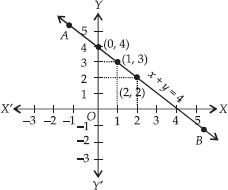
Thus, the line AB is the required graph of x + y = 4
(ii) x - y = 2 ⇒ y = x - 2
If we have x = 0, then y = 0 - 2 = -2
x = 1, then y = 1 - 2 = -1
x = 2, then y = 2 - 2 = 0
 We have the following table :
We have the following table :

Plot the ordered pairs (0, -2), (1, -1) and (2, 0) on the graph paper. Joining these points, we get a straight line PQ as shown.
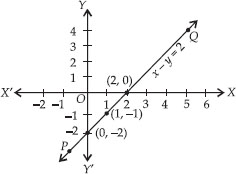
Thus, the line PQ is required graph of x - y = 2
(iii) y = 3x
If we have x = 0, then y = 3(0) ⇒ y = 0
x = 1, then y = 3(1) ⇒ y = 3
x = -1, then y = 3(-1) ⇒ y = -3
 We get the following table:
We get the following table:

Plot the ordered pairs (0, 0), (1, 3) and (-1, -3) on the graph paper. Joining these points, we get a straight line LM.
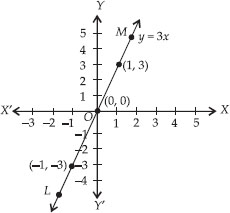
Thus, LM is the required graph of y = 3x.
(iv) 3 = 2x + y ⇒ y = 3 - 2x
If we have x = 0, then y = 3 - 2(0) ⇒ y = 3
x = 1, then y = 3 - 2(1) ⇒ y = 1
x = 2, then y = 3 - 2(2) = 3 - 4 = - 1
⇒ y = - 1
 We get the following table :
We get the following table :

Plot the ordered pairs (0, 3), (1, 1) and (2, - 1) on the graph paper. Joining these points, we get a line CD.
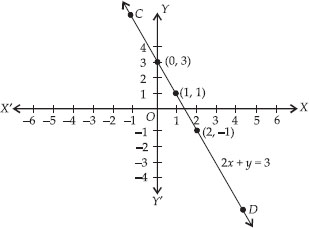
Thus, the line CD is the required graph of 3 = 2x + y.
Give the equations of two lines passing through (2, 14). How many more such lines are there, and why?
SOLUTION: (2, 14) means x = 2 and y = 14
Following equations can have (2, 14) as the solution, i.e. they can pass through the point (2, 14).
(i) x + y = 16
(ii) 7x - y = 0
There are infinite number of lines which passes through the point (2, 14), because infinite number of lines can pass through a point
If the point (3, 4) lies on the graph of the equation 3y = ax + 7, find the value of a.
SOLUTION: The equation of the given line is 3y = ax + 7
As,(3, 4) lies on the given line
it must satisfy the equation 3y = ax + 7
We have (3, 4) ⇒ x = 3 and y = 4, putting these values in equation, we get
3 x 4 = a x 3 + 7 ⇒ 12 = 3a + 7
⇒ 3a = 12 - 7 = 5 Therefore, 
Thus, the required value of a is 
The taxi fare in a city is as follows :
For the first kilometre, the fare is ₹ 8 and for the subsequent distance it is ₹ 5 per km. Taking the distance covered as x km and total fare as ₹ y, write a linear equation for this information and draw its graph.
Here, total distance covered = x km and total taxi fare =
₹y
Fare for the lst km = ₹8
Remaining distance = (x - 1) km
Therefore, Fare for (x - 1) km = ₹
5 x (x - 1)
Total taxi fare = ₹
8 + ₹
5(x - 1)
According to the condition,
y = 8 + 5(x - 1) ⇒ y = 8 + 5x - 5 ⇒ y = 5x + 3
Which is the required linear equation representing the given information.
Graph : We have y = 5x + 3
Therefore, When x = 0, then y = 5(0) + 3 ⇒ y = 3
x = - 1, then y = 5(-1) + 3 ⇒ y = -2
x = -2, then y = 5(-2) + 3 ⇒ y = -7
Therefore, We get the following table:

Now, plotting the ordered pairs (0, 3), (-1, -2) and (-2, -7) on a graph paper and joining them, we get a straight line PQ.
Thus, PQ is the required graph of the linear equati on y = 5x + 3
From the choices given below, choose the equation whose graphs are given in Fig. (1) and Fig. (2).
For Fig. (1)
(i) y = x
(ii) x + y = 0
(iii) y = 2x
(iv) 2 + 3y = 7x
For Fig. (2)
(i) y = x + 2
(ii) y = x - 2
(iii) y = -x + 2
(iv) x + 2y = 6
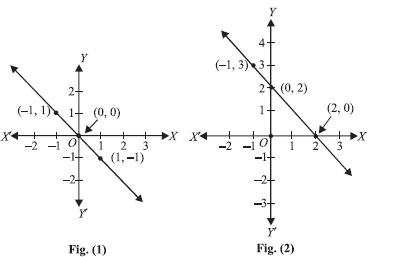
For Fig. (1), the correct linear equation is x + y = 0
[As (-1, 1) ⇒ -1 + 1 = 0
and (1, -1) ⇒ 1 + (-1) = 0]
For Fig. (2), the correct linear equation is y = -x + 2
[As (-1, 3) ⇒ 3 = -1(-1) + 2 ⇒ 3 = 3 and (0, 2) ⇒ 2 = -(0) + 2 ⇒ 2 = 2]
If the work done by a body on application of a constant force is directly proportional to the distance travelled by the body, express this in the form of an equation in two variables and draw the
graph of the same by taking the constant force as 5 units. Also read from the graph the work done when the distance travelled by the body is
(i) 2 units (ii) 0 unit
Constant force is 5 units. Let the distance travelled = x units and work done = y units.
Since, Work done = Force x Displacement
⇒ y = 5 x x ⇒ y = 5x
For drawing the graph, we have y = 5x
When x = 0, then y = 5(0) = 0
x = 1, then y = 5(1) = 5
x = -1, then y = 5(-1) = -5
Therefore, We get the following table:

Plotting the ordered pairs (0, 0), (1, 5) and (-1, -5) on the graph paper and joining the points, we get a straight line AB.
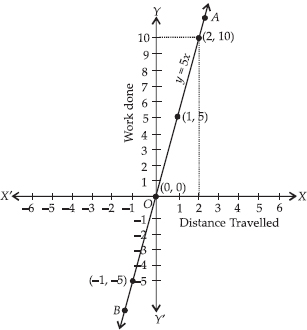
From the graph, we get
(i) Distance travelled = 2 units i.e., x = 2
If x = 2, then y = 10 units
⇒ Work done = 10 units.
(ii) Distance travelled = 0 unit i.e., x = 0
If x = 0 ⇒ y = 5(0) = 0
⇒ Work done = 0 unit.
Yamini and Fatima, two students of Class IX of a school, together contributed ' 100 towards the Prime Minister’s Relief Fund to help the earthquake victims. Write a linear equation
which satisfies this data. (You may take their contributions as ' x and ' y.) Draw the graph of the same.
Let the contribution of Yamini =
₹ x and the contribution of Fatima =
₹ y
 We have x + y = 100 ⇒ y = 100 - x
We have x + y = 100 ⇒ y = 100 - x
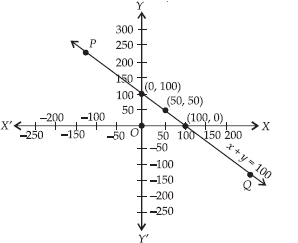
Now, when x = 0, y = 100 - 0 = 100
x = 50, y = 100 - 50 = 50
x = 100, y = 100 - 100 = 0
 We get the following table:
We get the following table:

Plotting the ordered pairs (0, 100), (50, 50) and (100, 0) on a graph paper and using proper scale and joining these points we get a line PQ.
In countries like USA and Canada, temperature is measured in Fahrenheit, whereas in countries like India, it is measured in Celsius. Here is a linear equation that converts Fahrenheit to
Celsius.

(i) Draw the graph of the linear equation above using Celsius for x-axis and Fahrenheit for y-axis.
(ii) If the temperature is 30°C, what is the temperature in Fahrenheit?
(iii) If the temperature 95°F, what is the temperature in Celsius?
(iv) If the temperature is 0°C, what is the temperature in Fahrenheit and if the temperature is 0°F, what is the temperature in Celsius?
(v) Is there a temperature which is numerically the same in both Fahrenheit and Celsius ? If yes, find it.
(i) We have 
When C = 0, 
When C = -15, 
When C = - 10,  = - 18 + 32 = 14
= - 18 + 32 = 14
We have the following table:

Plotting the ordered pairs (0, 32), (-15, 5) and (-10, 14) on a graph paper. Joining these points we get straight line AB.
(ii) From the graph, we have 86°F corresponds to 30°C
(iii) From the graph, we have 95°F = 35°C
(iv) From the graph, we have 0°C = 32°F and 0°F = - 17.8°C
(v) When F = C (numerically)
From given equation, we get


Temperature is - 40° both in F and C.
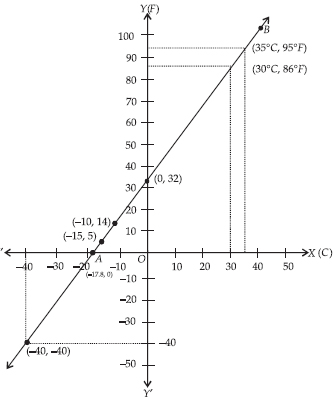
Give the geometric representations of y = 3 as an equation
(i) in one variable (ii) in two variables
(i) y = 3
because y = 3 is an equation in one variable, i.e. y only.
 It has a unique solution y = 3 as shown on the number line shown here.
It has a unique solution y = 3 as shown on the number line shown here.

The unique solution is a point.
(ii) y = 3
We can write y = 3 as 0 · x + y = 3
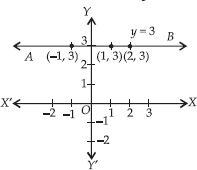
Now, when x = 1, y = 3
x = 2, y = 3
x = - 1, y = 3
 We get the following table:
We get the following table:

Give the geometric representations of 2x + 9 = 0 as an equation
(i) in one variable (ii) in two variables
(i) 2x + 9 = 0
We have: 2x + 9 = 0 ⇒ 2x = - 9

which is a linear equation in one variable i.e., x only. Its solution is the point
 on the number line as shown below.
on the number line as shown below.

(ii) 2x + 9 = 0
We can write 2x + 9 = 0 as 2x + 0 · y + 9 = 0

 When y = 1,
When y = 1,

When y = 2,

When y = 3,

When y = 1, 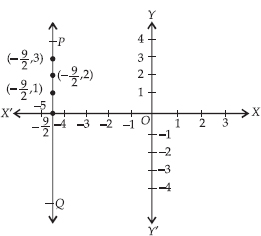
Thus, we get the following table:

Now, plotting the ordered pairs  and
and
 on a graph paper and joining them, we get a line PQ as solution of 2x + 9 = 0.
on a graph paper and joining them, we get a line PQ as solution of 2x + 9 = 0.